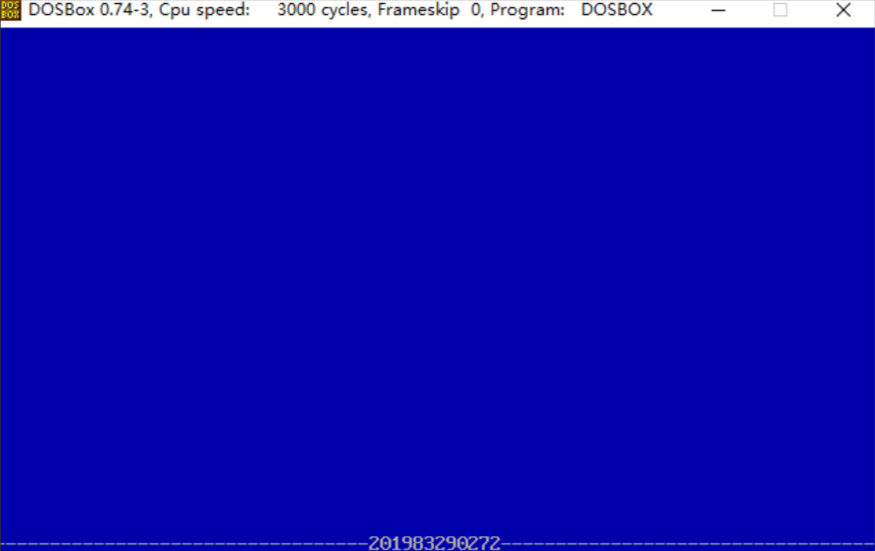Experiment Task 1
assume cs:code, ds:data data segment x db 1, 9, 3 len1 equ $ - x ; y dw 1, 9, 3 len2 equ $ - y ; data ends code segment start: mov ax, data mov ds, ax mov si, offset x ; mov cx, len1 ; mov ah, 2 s1:mov dl, [si] or dl, 30h int 21h mov dl, ' ' int 21h ; inc si loop s1 mov ah, 2 mov dl, 0ah int 21h ; mov si, offset y ; mov cx, len2/2 ; mov ah, 2 s2:mov dx, [si] or dl, 30h int 21h mov dl, ' ' int 21h ; add si, 2 loop s2 mov ah, 4ch int 21h code ends end start
Run result: Output two lines 19 3

(1) line27, the assembly instruction loop s1 jumps according to the amount of displacement. Through debug disassembly, look at its machine code and analyze how much displacement it jumps? (Displacement values are answered in decimal numbers) From the perspective of the CPU, how to calculate the offset address of the instruction following the jump label s1.
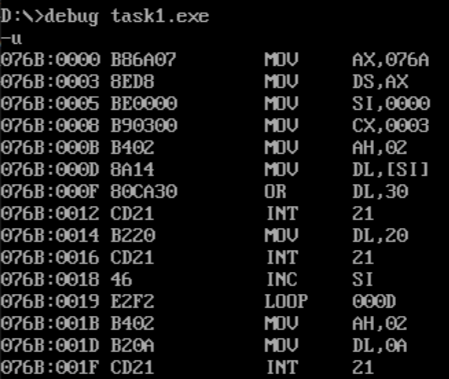
The displacement is: 14 (Loop instruction end address: 001B, s1 instruction start address: 000D, 001B-000D=14)
Analysis: or dl, 30h command takes up three bytes, inc command takes up one byte, other commands take up two bytes, totaling 14 bytes.
(2) line44, the assembly instruction loop s2 jumps according to the amount of displacement. Through debug disassembly, look at its machine code and analyze how much displacement it jumps? (Displacement values are answered in decimal numbers) From the perspective of the CPU, how to calculate the offset address of the instruction following the jump label s2.
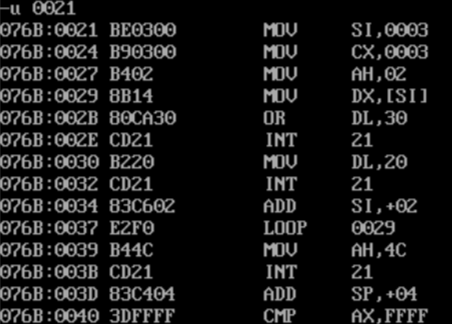
The displacement is: 16 (Loop instruction end address: 0039, s1 instruction start address: 0029, 001B-000D=16)
Analysis: or dl, the 30h command takes up three bytes, and the other commands take up two bytes, totaling 16 bytes.
Experiment Task 2
assume cs:code, ds:data
data segment
dw 200h, 0h, 230h, 0h
data ends
stack segment
db 16 dup(0)
stack ends
code segment
start:
mov ax, data
mov ds, ax
mov word ptr ds:[0], offset s1
mov word ptr ds:[2], offset s2
mov ds:[4], cs
mov ax, stack
mov ss, ax
mov sp, 16
call word ptr ds:[0]
s1: pop ax
call dword ptr ds:[2]
s2: pop bx
pop cx
mov ah, 4ch
int 21h
code ends
end start
Question 1

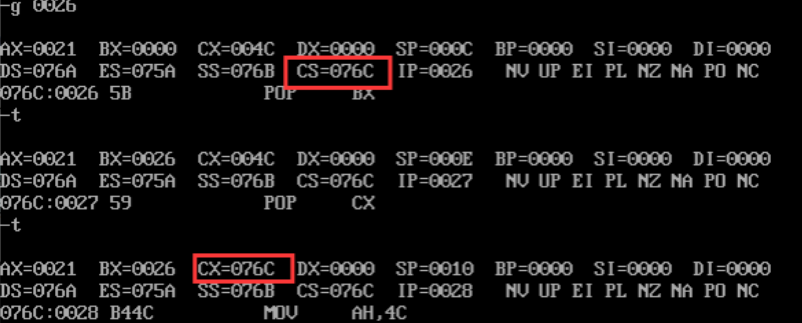
Experiment Task 3
assume cs:code, ds:data
data segment
x db 99, 72, 85, 63, 89, 97, 55
len equ $ - x
data ends
code segment
start:
mov ax,data
mov ds,ax
mov byte ptr ds:[len],10
mov cx,7
mov bx,0
s: mov al,ds:[bx]
mov ah,0
inc bx
call printNumber
call printSpace
loop s
mov ah,4ch
int 21h
printNumber:
div byte ptr ds:[len]
mov dx,ax
mov ah,2
or dl,30h
int 21h
mov ah,2
mov dl,dh
or dl,30h
int 21h
ret
printSpace:
mov dl,' '
mov ah,2
int 21h
ret
code ends
end start
Run Test Screenshot
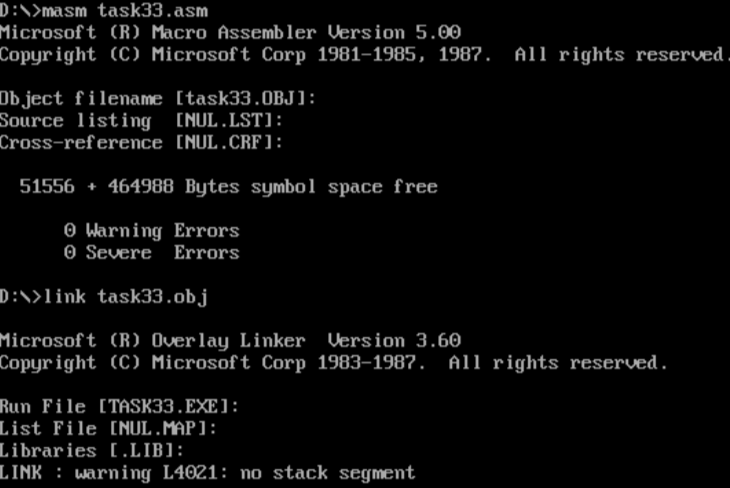

Experiment Task 4
assume cs:code,ds:data
data segment
str db 'try'
len equ $ - str
data ends
code segment
start:
mov ax, data
mov ds, ax
mov bl, 2
mov bh, 0
call printStr
mov bl, 4
mov bh, 24
call printStr
mov ax, 4c00h
int 21h
printStr:
mov ax, 0b800h
mov es, ax
mov si, offset str
mov cx, len
mov al,0A0h
mul bh
mov di, ax
s: mov al,[si]
mov es:[di], al
mov es:[di+1], bl
inc si
add di, 2
loop s
ret
code ends
end start
Run Test Screenshot:

Experiment Task 5
assume ds:data, cs:code
data segment
stu_no db '201983300980'
len = $ - stu_no
data ends
code segment
start:
mov ax, data
mov ds, ax
mov cx, 4000
mov si, offset stu_no
mov ax, 0b800h
mov es, ax
mov di, 0
mov ah,17h
s: mov al, 0
mov es:[di], al
mov es:[di+1], ah
inc si
add di, 2
loop s
mov di, 3840
mov si, offset stu_no
mov cx, 74
mov ah, 17h
s1: call printgang
add di, 2
loop s1
mov di, 3908
mov si, offset stu_no
mov cx, len
mov ah, 17h
s2: call printStu_no
inc si
add di, 2
loop s2
mov di, 3932
mov si, offset stu_no
mov cx, 74
mov ah, 17h
s3: call printgang
add di, 2
loop s3
mov ax, 4c00h
int 21h
printStu_no:mov al, [si]
mov es:[di], al
mov es:[di+1], ah
ret
printgang:mov al, 45
mov es:[di], al
mov es:[di + 1], ah
ret
code ends
end start
Run result screenshot:
